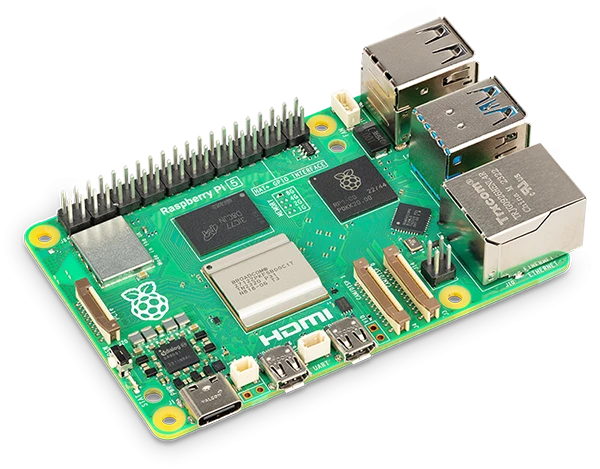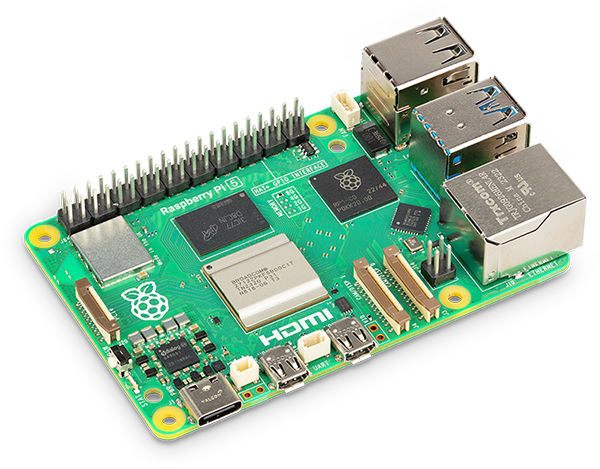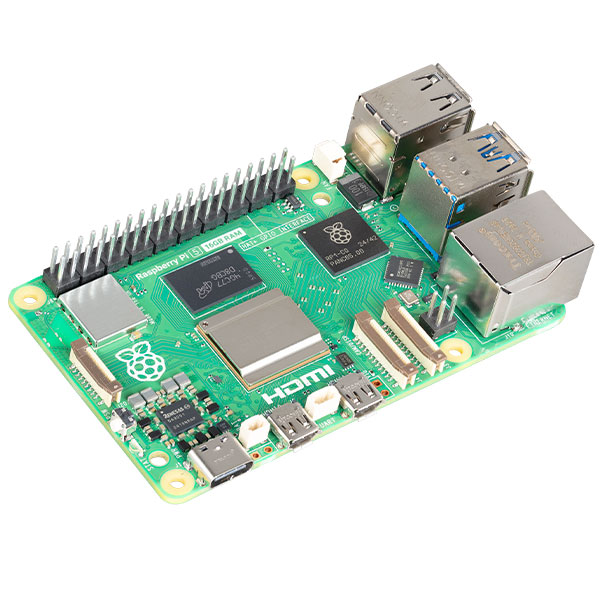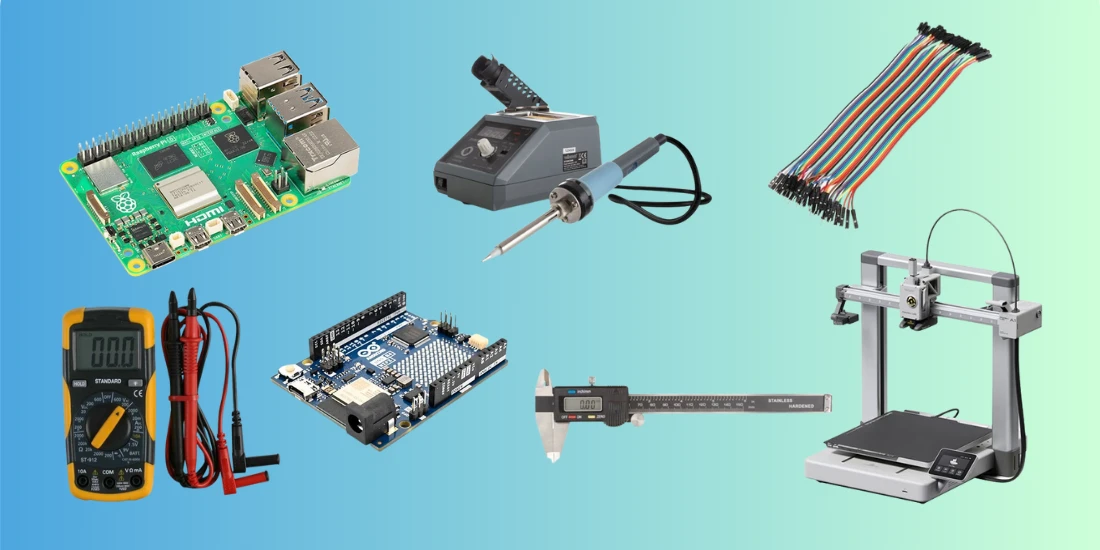5220+ reviews
Order by 16:00 for same day shipping
14 days return
DE
EN
Individual
Business

15/05/2025
The New Raspberry Pi 5 is Here!
We have some great news for all you Raspberry Pi lovers: the Raspberry Pi 5 has been announced. As the successor to the Raspberry Pi 4, this new version promises several improvements and features. The Raspberry Pi 5 is expected to be released in two phases, with the first 4GB and 8GB versions available on October 23rd, followed by the 1GB and 2GB variants at a later date. We wanted to give you an overview of what to expect, and what makes this release special compared to previous models.
What is a Raspberry Pi 5?
A Raspberry Pi 5 is a compact computer in the form of a small printed circuit board. It is designed for educational purposes, hobby projects and various applications ranging from home automation to industrial applications. The Raspberry Pi 5 uses an ARM-based processor and comes with various hardware capabilities that make it suitable for various projects.
What Can a Raspberry Pi 5 Do?
The Raspberry Pi 5 can generally do what a Raspberry Pi 4 can do, only the 5 performs better. A Raspberry Pi 5 can perform a wide range of tasks and projects, for example:
- Programming and Learning : It is an excellent platform to learn programming in languages like Python, C++, and more.
- Home Automation: You can use it to manage your smart home, including lights, thermostat, security systems, and more.
- Media Center : Transform it into a media server to stream videos and music to your TV.
- IoT Projects : Build Internet of Things (IoT) devices to monitor and manage your home or office.
- Robotics : Create robots and automated systems for educational and hobby projects.
- Educational Projects : Use it for educational experiments, science projects and simulations.
- Retro Gaming: Build a retro gaming console to play classic video games.
- Network Management : Learn network management and configuration using the Raspberry Pi .
- 3D Printing and CNC : Use it as a controller for 3D printers or CNC machines.
- AI Development: Raspberry Pi 5 can be used as an affordable development platform for AI projects. You can train and deploy machine learning models for image recognition, natural language processing, and other AI applications.
- Industrial Automation: In the industrial sector, the Raspberry Pi 5 can be used for data acquisition, control systems, and machine monitoring. It can be integrated into automation systems to improve productivity and efficiency.
Raspberry Pi 5 specifications
CPU: Quad-core 64-bit Arm Cortex-A76
This quad-core, 64-bit Arm Cortex-A76 CPU is clocked at 2.4GHz and features 512KB L2 caches and a generous 2MB shared L3 cache. This makes the CPU 2-3x more powerful than its predecessors and makes suitable for a wide range of tasks. With four cores and a 64-bit architecture, the CPU is able to perform complex calculations and multitasking tasks quickly and efficiently.
GPU: VideoCore VII
In addition to its impressive CPU, the Raspberry Pi 5 is equipped with the VideoCore VII GPU. This graphical processing power provides a better visual experience, ideal for graphic-intensive applications and games. The GPU provides fast and smooth graphics, resulting in an improved user experience.
Memory: LPDDR4X-4267 SDRAM 1GB, 2GB, 4GB and 8GB
Memory is essential to the responsiveness of a computer, and the Raspberry Pi 5 offers options to suit different needs. With LPDDR4X-4267 SDRAM, the Pi 5 has fast memory for rapid data transfers and smooth operation. At launch, both 4GB and 8GB are available available. Later the 1GB and 2GB will also be available. So you can choose the amount of memory that best suits your project. The resistor on the Raspberry Pi 5 clearly indicates how much RAM memory is available.
Wireless Connectivity: 2.4GHz and 5.0GHz 802.11ac Wi-Fi
Thanks to dual-band 802.11ac Wi-Fi, the Raspberry Pi 5 can connect to both 2.4GHz and 5.0GHz wireless networks. This gives you faster and more reliable wireless connectivity, which is useful for internet access and streaming of data.
Bluetooth: Bluetooth 5.0/ Bluetooth Low Energy (BLE)
The Raspberry Pi 5 is equipped with Bluetooth 5.0 and Bluetooth Low Energy (BLE), making it possible to connect to a wide range of wireless devices. This is useful for wireless speakers, keyboards, mice or other Bluetooth-based accessories.
Micro SD Card Slot with SDR104 Mode for Fast Data Transfer
The Pi 5 has a micro SD card slot with support for SDR104 mode. This allows you to quickly transfer and store data to a micro SD card, which is essential for loading operating systems and storing data and programs. The data transfer of the Raspberry Pi 5 is significantly faster than that of the Raspberry Pi 4B.
- USB Ports: Fast Data Transfer with USB 3.0
The Raspberry Pi 5 features 2× USB 3.0 ports, supporting simultaneous 5Gbps operation. This means you can connect peripherals and benefit from faster data transfer rates for tasks like transferring files or connecting external storage devices.
Ethernet: Gigabit Ethernet with PoE+ Option
For wired network connections, the Pi 5 has built-in Gigabit Ethernet. It also offers PoE+ (Power over Ethernet) support, but this requires a dedicated PoE+ HAT. Gigabit Ethernet delivers fast speeds for stable wired network connections, ideal for applications where reliable connectivity is required. The Raspberry Pi 5 uses a new, significantly smaller PoE+ HAT compared to the one on the Pi 4, allowing this HAT to also fit perfectly into the original Pi 5 case.
Camera and Display
Both camera and display interfaces are available on the Raspberry Pi 5 via 2×4 lane MIPI camera/display transceivers. These interfaces allow for the connection of advanced cameras and displays for a wide range of applications. This also makes it possible to connect two cameras or two displays simultaneously.
PCIe interface
A notable new feature of the Raspberry Pi 5 is the PCIe 2.0 x1 interface. This interface provides support for high-speed peripherals such as SSDs or other PCIe devices. This opens the door to expansion possibilities and makes the Pi 5 even more versatile.
Power supply: 5V/5A DC power supply with Power Delivery
The Raspberry Pi 5 requires a 5V/5A power supply, which can provide reliable power for various applications. Additionally, the Pi 5 supports Power Delivery (PD), which provides flexibility in powering the Pi 5.
GPIO header
The 40-pin GPIO header on the Raspberry Pi 5 offers a wide range of options for connecting external devices and expansion boards, allowing you to tailor the Pi 5 to your specific project needs.
Real-Time Clock (RTC) with External Battery Power
The RTC on the Pi 5 provides accurate timekeeping and can be powered by an external battery. This keeps the clock running even when the Pi 5 is powered off, which is useful for applications that rely on time data.
On/off button
A handy addition to the Raspberry Pi 5 is the on-board power button. Unlike the Raspberry Pi 4B, which didn't have this feature, the power button on the Pi 5 makes it easy to switch the device on and off without having to disconnect the power.
RP1 I/O Controller Chip
The Raspberry Pi 5 has an RP1 I/O controller chip. The RP1 I/O controller chip improves the interfacing with cameras, displays and USB ports. This is the very first time that Raspberry Pi 5 has its own chip used on a Raspberry Pi , which is a major innovation.

Raspberry Pi 5 vs Raspberry Pi 4
The Raspberry Pi 5 builds on the phenomenal success of its predecessor, the Raspberry Pi 4. In this comparison, we’ll discuss some of the notable improvements in the Pi 5 over the Pi 4, making it a more powerful and versatile device.
CPU and GPU performance:
The Raspberry Pi 5 differentiates itself from its predecessor, the Pi 4, by offering impressive improvements in CPU and GPU performance. Featuring a powerful 2.4GHz quad-core, 64-bit Arm Cortex-A76 CPU and a VideoCore VII GPU, the Pi 5 sees a significant increase in performance. This upgrade results in a noticeable 2-3x increase in CPU performance over the Pi 4, meaning the Pi 5 is even better suited for demanding tasks and compute-intensive projects.
Memory:
In terms of memory, the Pi 5 offers even more flexibility. While the Pi 4 comes in 2GB, 4GB, and 8GB RAM variants, the Pi 5 launches with LPDDR4X-4267 SDRAM and offers the choice of 1GB, 2GB, 4GB, and 8GB. This makes it easier to tailor the Pi 5 to specific project needs.
Wireless Connectivity:
A major upgrade in wireless connectivity can be seen on the Pi 5. This new version features support for dual-band 802.11ac Wi-Fi, operating at both 2.4 GHz and 5.0 GHz. In comparison, the Pi 4 only had single-band Wi-Fi. Additionally, the Pi 5 features Bluetooth 5.0/ Bluetooth Low Energy (BLE) for wireless devices, allowing for more connectivity options.
USB Ports:
Both models, the Pi 4 and Pi 5, feature USB 3.0 and USB 2.0 ports for connecting peripherals. However, the Pi 5 stands out for its support for simultaneous 5Gbps operation on its USB 3.0 ports. This results in improved performance when connecting USB peripherals, which is particularly useful for data-intensive tasks.
Camera and Display:
Both models, the Pi 4 and Pi 5, support advanced cameras and displays via MIPI transceivers. While the exact performance differences are still to be determined, the Pi 5 may offer improved performance in terms of camera and display interfacing, making it ideal for applications where visual input and output are essential.
PCIe interface:
One of the notable new features of the Raspberry Pi 5 is the PCIe 2.0 x1 interface. This interface allows for the connection of high-speed peripherals and offers new possibilities for expandability. The Pi 4 does not have this feature, which gives the Pi 5 an advantage when expanding its capabilities with external hardware.
Power button: On-board power button
A handy addition to the Raspberry Pi 5 is the on-board power button. Unlike the Raspberry Pi 4B, which didn’t have this feature, the power button on the Pi 5 makes it easy to turn the device on and off without having to disconnect power.
RP1 I/O Controller Chip
The RP1 I/O controller chip has enabled improvements in the interfacing of various aspects, such as the camera, display and USB connections. The RP1 I/O controller chip is made by Raspberry Pi itself. The Raspberry Pi 4B did not have this.
Two connections for cameras and screens
The Raspberry Pi 5 has something special: two connections for cameras and screens. The Raspberry Pi 4B did not have this. This means that you can easily use two cameras for projects with 3D images or two screens for information boards, for example. It is also possible to connect a screen and camera at the same time. This gives you a lot of freedom and creative possibilities for your projects.
Fan port
The Raspberry Pi 5 also has a fan port to which a fan can be connected. The fan speed can be easily adjusted via the software. The Raspberry Pi 4B did not have this.
Graphics processor
Thanks to the improved graphics processor, the Raspberry Pi 5 produces significantly sharper camera images compared to the Raspberry Pi 4.
These improvements are reflected in the price of the Raspberry Pi 5. The boards are slightly more expensive compared to the Pi 4 boards. However, these improvements are definitely worth the price. If you want a new setup, it is best to buy a Raspberry Pi 5.

Raspberry Pi 5 Accessories
With the release of the Raspberry Pi 5 comes not only a new generation of this powerful and versatile microcomputer. But also a range of new accessories that extend the functionality of the Raspberry Pi even further.
Compatibility with Existing Accessories:
A notable feature of the Raspberry Pi 5 is that it is compatible with a wide range of existing accessories and add-ons available for previous Raspberry Pi models, including the Raspberry Pi 4 and other versions. This means that if you already have accessories such as cameras, displays, and more for previous Pi models, you can continue to use them with the Raspberry Pi 5 with ease. Connecting displays and cameras will require a new type of cable, and Raspberry Pi will make these new cables available as well.
- The new 27W USB-C PD (Power Delivery) power adapter delivers up to 5.1V and 5A, allowing the Raspberry Pi 5 to power a wider range of peripherals.
- A PD power supply, or Power Delivery power supply, accelerates the delivery of power to electronic devices like the Raspberry Pi 5 by intelligently communicating with the device for optimal charging speed and voltage. This results in more efficient and faster charging compared to traditional chargers.
- Normally, the total power drawn from the four USB ports on the Raspberry Pi 5 is limited to 600mA by default. This limit is automatically increased to 1.6A when the USB-C PD power adapter is detected.
- The USB-C PD power adapter is also capable of delivering 3A @ 9V, 2.25A @ 12V, and 1.8A @ 15V to PD compatible products, making it a cost-effective power adapter for many general purpose applications, even beyond the Raspberry Pi .
- The PD power adapter is also ideal for charging smartphones through the PD function.
- Specifications:
- Input: 100-240VAC
- Output: 5A @ 5.1V, 3A @ 9V, 2.25A @ 12V, 1.8A @ 15V
- Connection: USB-C
- Cable: 1.2m, 18AWG
- Colors: White, black
- The new case is an improved version of the Raspberry Pi 4 case and offers better thermal properties to support the higher peak power consumption of the Raspberry Pi 5.
- It includes a variable speed fan, which is powered and controlled via a dedicated connector on the Raspberry Pi 5 PCB.
- At launch, the case will be available in the signature red/white color scheme.
- The air intake and exhaust have been significantly improved, ensuring more efficient air circulation.
- Both the Pi5 PoE+ HAT and the Sense HAT fit seamlessly into the enclosure.
- By using spacers you can easily stack the housing.
- It is possible to already insert the microSD card into the Pi and then place the whole unit into the case. This prevents damage to the microSD cards and saves time.
These new accessories are designed to further enhance the functionality and performance of the Raspberry Pi 5, giving users greater flexibility when using this powerful single-board computer platform.
The Active Cooler offers an alternative cooling solution for users who wish to use their Raspberry Pi 5 under heavy and prolonged loads without a case. This cooler combines a large metal heatsink with a variable speed blower, which is again powered and controlled via the fan connector. It attaches to the Raspberry Pi 5 PCB via spring pins in a pair of mounting holes.
The power management IC used on the Raspberry Pi 5 integrates a real-time clock and charging circuitry for a coin cell battery that can power the clock when the main power is disconnected. We provide a Panasonic ML-2020 Lithium Manganese Dioxide battery, with a two-pin connector suitable for connecting to the battery connector on the Raspberry Pi 5 PCB, along with a double-sided adhesive strip for attaching it to the inside of a case or other convenient location.
Camera and Display Adapter Cables:
The Raspberry Pi 5 provides two four-lane MIPI connectors, each suitable for connecting a camera or a display. These connectors use the same 22-way, 0.5mm-pitch “mini” FPC format as the Compute Module Development Kit, and require adapter cables to connect to the 15-way, 1mm-pitch “standard” connectors on our current camera and display products. We offer mini-to-standard adapter cables for both cameras and displays, available in 200mm, 300mm, and 500mm lengths.
Raspberry Pi 5 Desktop Kit:
This is the latest version of the Desktop Kit and includes a Raspberry Pi 5 case, a 27W USB-C PD power adapter, a keyboard, a mouse, a 32GB SD card with Raspberry OS Bookworm pre-installed, two micro HDMI cables and the Raspberry Pi Beginner's Guide 5. You can then choose between the Raspberry Pi 4 4GB or 8GB.
Raspberry Pi 5 PoE+ HAT:
This is an updated PoE+ HAT designed to support the physical layout and power requirements of the Raspberry Pi 5. Due to its L-shaped design and low profile, it can be used in the new Raspberry Pi 5 case with the fan and top cover in place.
Raspberry Pi 5 M.2 HAT:
The M.2 HAT supports connecting M.2 format PCIe and NVMe devices to the PCIe FPC connector on the Raspberry Pi 5. This allows users to leverage the powerful capabilities of M.2 storage and expansion cards.
Guidelines for Safe Use:
- Overclocking: Do not use this product with overclocking settings. Keep the default performance configuration.
- Protection against Water and Moisture: Do not allow this product to come into contact with water or damp conditions. Do not place it on surfaces that conduct electricity.
- Avoid Heat Sources: Exposure to direct heat sources should be avoided. This product is designed to operate reliably at normal room temperature.
- Intense Light Sources: Protect this board from high intensity light sources such as xenon flashes or lasers.
- Ventilation: Always use this product in a well-ventilated environment. Do not cover it during use to prevent overheating.
- Stable and Non-Conductive Surface: Place this product on a stable, flat surface that does not conduct electricity. Avoid contact with conductive materials.
- Caution when Handling: Use caution when handling this product to avoid both mechanical and electrical damage to the printed circuit board and connectors.
- Power Disconnect: Disconnect the power to this product before making any changes. To minimize the risk of electrostatic discharge damage, handle the board only by its edges.
- Standards Compliance: Ensure that all peripherals and devices used with the Raspberry Pi comply with applicable standards in the country of use and are appropriately marked to meet safety and performance requirements.






